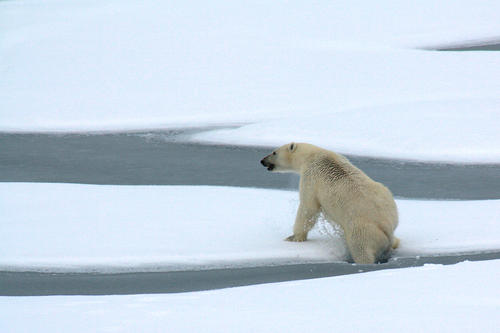Digging Deeper: The Fate of Arctic Habitats
In comparison to other portions of the Earth, the Arctic is undergoing the most rapid change in temperature as a result of climate change. Recent warming has had a drastic affect on surface processes, the well-being of animal species, and the geography of plants. The dramatic warming in Alaska has increased the growing degree days for agriculture and forestry by twenty percent. Boreal forests are expanding their range at a rate of 100 to 150 km per oC increase in temperature. With warmer temperatures comes longer and deeper thaw cycles resulting in thermokarst and wetlands in the forest. The annual area burned in northwestern North America has doubled over the last twenty years and Eurasian forests have experienced similar trends.
Warming temperature in the Arctic is thawing permafrost making coasts and slopes along streams more susceptible to erosion and mass movement. Thaw slumps, sliding masses of soft soil, slide into pristine streams turning them muddy and smothering fish eggs waiting to hatch from gravels that line river beds. Coastal erosion results in a loss of land habitat for those living on the North Slope, a trend that is predicted to continue into the future.
A Pew Center review of current research indicates that nearly half of known wild species have been affected by global warming. For example, polar bear populations are on the decline as arctic sea ice thins making for precarious hunting conditions. Polar bears prowl the ice floes in search of food, notably seals. These white giants capture their prey by waiting for seals to appear in air holes in the ice. Packing on fat from rich seal meat enables them to survive when the ice melts making prey harder to find.
Figure DD.13.4 Polar bear on
ice floe.

Courtesy NOAA
The warming oceans and melting sea ice have shortened polar bear access to food. In Canada's West Hudson Bay, sea ice is breaking up three weeks earlier as a result of changing climate conditions. Polar bear populations are down twenty percent in the last ten years as fewer cubs are born or make it to adulthood. Ice pack break up leaves polar bears stranded farther from land, sometimes drowning from trying to swim longer distances. In the northern part of Alaska polar bears are moving inland as the Arctic sea ice coverage shrinks.
Video: "Melting Ice Could Erode Way of Life for Alaska's North Slope"
(Courtesy PBS Newshour)
New novel climates will appear while other climates may disappear with future global warming. The Arcitc is forecast to undergo some of the greatest changes in climate patterns. Climate models indicate that the tundra will be retreat to northern coasts and islands of the Arctic Ocean. Tundra vegetation will be replaced by boreal forests and shrubs.